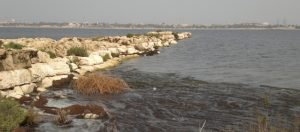Lagoon archaeology in the Alexandria region, Nile delta, Egypt
Portus Limen Seminar Series
13th october 2015 5:00 pm
University of Southampton, Computer Lab, room 3043, building 65a, Avenue Campus
Lagoon archaeology in the Alexandria region, Nile delta, Egypt
By Dr. Clément Flaux (Post-doc CNRS, Ecolab, Toulouse University and CEREGE, Aix-Marseille University), with great contributions from : M. el-Assal, W. Chazly, N. Marriner, C. Morhange, V. Pichot, C. Shaalan

The Mareotide is part of the Alexandrian countryside, primarily characterized by a huge coastal lagoon, named Lake Mareotis in Antiquity (modern-day Maryut Lake). The Lake Mareotis has revealed numerous harbour structures, especially in its western arm. Quays, lakewalls, jetties, piers, moles, causeways, fishponds, navigation channel, constructed harbour and harbour-like protected inlets flourished in the vocabulary of survey reports and became a typical feature of the Maryut shores, spanning the period from the 3rd century BC to the 7th century AD. Since 2008, in the framework of those extensive archaeological surveys and excavations led in the lagoonal region, our team have contributed to the understanding of the palaeo-environmental context, in collaboration with the CEAlex (CNRS, Alexandria).
A series of ca. 100 sediment cores were taken from the Maryut sediment reservoir, the ancient Canopic branch area, or within archaeological contexts, in order to select and decipher available environmental archives. Detailed analysis of macrofauna and microfauna assemblages, sedimentology, Sr isotopic ratio and radiocarbon dating have allowed to reconstitute one hydrological history of Mayut lake since 7500 years. These environmental proxies were used in conjunction with archaeological indicators to reconstruct lake water budgets, lake levels and subsequent palaeo-geographies.
Our palaeo-environmental archives evidence 3 periods of severe hydrological changes in the region : a drastic desalinisation of a marine lagoon toward the 10th century BC, a lake level rise during Roman time, and the dessication of the lake in the 9-10th century AD. These regional-scale changes in the hydraulic network can be compared with the settlement history provided by extensive archaeological surveys in the NW Nile deta. Impact of lake-level changes can also be. Both highlight a complex inter-connexion of humans impact and response to lagoon changes. This research is a contribution to the lagoonal archaeology of the Alexandria region, funded by the French Research National Agency (project GEOMAR, ANR-12-SENV-0008-03).
The author initiated fieldworks in the Mareotide region in 2008 and spends several months in Alexandria countryside each year. He defended its PhD thesis about Maryut palaeo-environments at Aix-Marseille University in 2012 and since then he has participated in projects dealing with lagoonal archaeology in the regions of Alexandria, Narbonne (France) and Alepu (Bulgaria).

